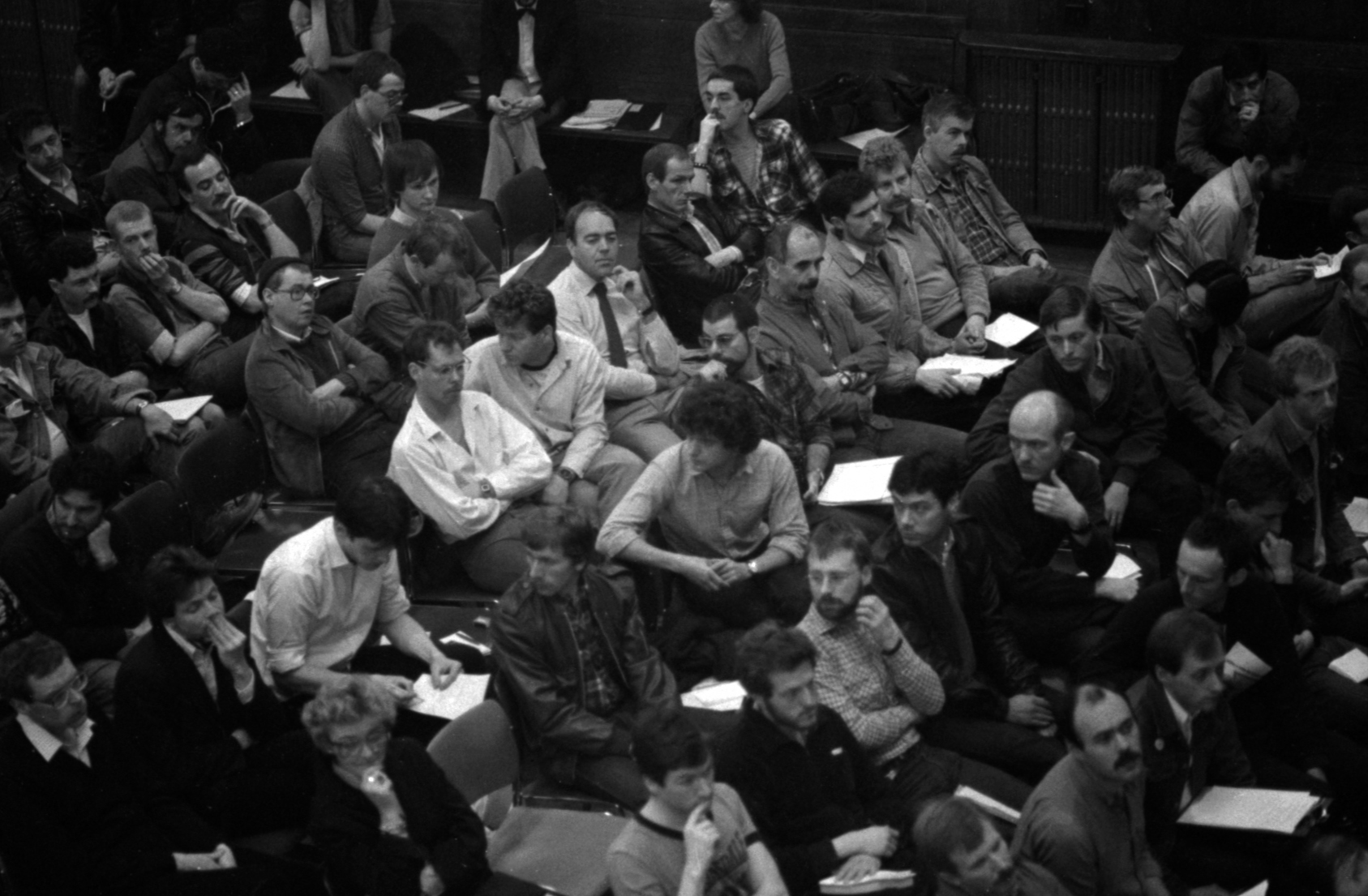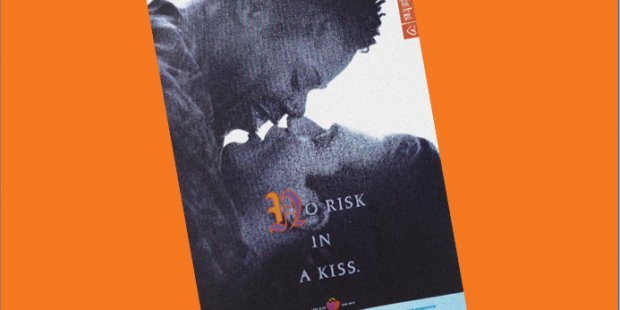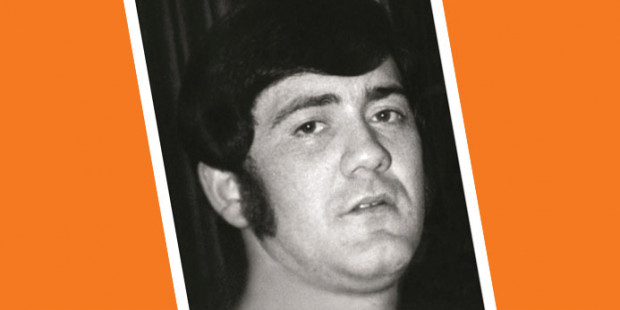Content
Image

Public meeting at Conway Hall, 1983 (Robert Workman Archive, Bishopsgate Institute)
1981
Text
- First cases of 'Gay-Related Immune Deficiency' (GRID) are identified in the United States.
1982
Text
- Terry Higgins dies at St Thomas' Hospital. The Terry Higgins Trust is set up.
- GRID is renamed Acquired Immune Deficiency Syndrome (AIDS) after the same immune deficiency syndrome is found in Haitians and heterosexual women.
1983
Text
- Three thousand AIDS cases have been reported in the USA with 1,000 dead.
- London Gay Switchboard and the Gay Medical Association hold a public meeting about AIDS at Conway Hall.
- A second public meeting is held at the London Apprentice in August – we're reborn as the Terrence Higgins Trust.
- The first Terrence Higgins Trust health promotion leaflet is published, and the first appeal for Buddies is made.
- France's Pasteur Institute discovers lymphadenopathy associated virus (LAV). Researchers believe causes AIDS, meaning that it is an infectious condition.
- Television programmes Panorama and Horizon run documentaries about the new disease.
- Scottish Aids Monitor (SAM) is set up to educate gay men about the threat of HIV and AIDS.
1984
Text
- Terrence Higgins Trust becomes a registered charity and we move into our first office: one room at Panther House in Mount Pleasant.
- The Helpline starts up, operating from 8pm to 10pm on weekdays.
- We form Europe's first People with AIDS (PWA) support group, and our first national conference, 'AIDS UK 84'.
- In the US, Dr Robert Gallo isolates the retrovirus called HTLV-III, which is also believed to cause AIDS.
- HIV genetic variations are discovered, making the development of a vaccine more difficult.
- The first European AIDS conference is held.
- By the end of 1984, there have been 108 AIDS cases and 46 deaths in the UK.
1985
Text
- We apply to the Greater London Council (GLC) for a £17,000 grant to pay staff salaries. Westminster Council challenges the validity of the GLC's decision to award Terrence Higgins Trust a grant and is overruled by the High Court.
- The first Terrence Higgins Trust candlelight vigil is held in Trafalgar Square.
- We rent a second room in Panther House and employ our first two full-time paid members of staff. One of them is Nick Partridge, who went on to become our chief executive.
- The first meeting takes place between Terrence Higgins Trust and the government.
- Scientists agree that the LAV and HTLV-III viruses are the same.
- The Department of Health publishes its first advice on AIDS to medical practitioners.
- The Health Education Council produces its first literature on AIDS.
- Actor Rock Hudson dies with AIDS.
- Body Positive, the first UK self-help group for people with HIV, is founded in London.
- AIDS reported in 51 countries.
- First report of the transmission of the virus from mother to child through breastfeeding is published.
- An HIV test is developed and blood donation centres start screening for HIV.
- GUM clinics start offering HIV testing.
- HIV arrives among the drug injecting population on the east coast of Scotland and the introduction of a number of punitive measures around needle possession rapidly generate an HIV epidemic. Subsequent prevention strategies, including the introduction of a network of needle exchanges and methadone maintenance programmes, lead to the successful containment of the epidemic.
1986
Text
- The Legal Services Group is set up to offer legal consultancy to clients.
- Interfaith Group, Women's Group and Family Support Group are set up.
- We produce our first safer sex video, Gearing Up for Safer Sex, with Clean Cut.
- The World Health Organisation (WHO) launches its global AIDS strategy.
- UK government sets up a Cabinet Committee on AIDS.
- The government launches its first AIDS health education campaign, ‘Don’t Aid Aids’, which has little public impact.
- John Fitzpatrick is appointed our first chief executive.
1987
Text
- Terrence Higgins Trust moves to Gray's Inn Road in King's Cross, London.
- We employ our first health education officer, health information officer, volunteer co-ordinator and legal officer.
- Stephen Fry produces ‘Hysteria’, a comedy benefit for Terrence Higgins Trust.
- The government launches the 'Don't Die of Ignorance' campaign and delivers the campaign leaflet to every household.
- Our phone number is listed as a source of information and advice on the government leaflet.
- Princess Diana opens the first specialist AIDS hospital ward in England at Middlesex Hospital.
- UK HIV organisations Positively Women and the National AIDS Trust are launched.
- The Football Association warns players not to use communal baths or to swap shirts at the end of a game.
- The AIDS memorial quilt is started by San Francisco gay rights activist Cleve Jones, who made the first panel in memory of his friend Marvin Feldman.
- Photographs taken by John Sturrock of people living with HIV/AIDS on the Muirhouse Housing Estate, Edinburgh, serve as the initial inspiration for the Postive Lives project.
1988
Text
- We employ our first welfare rights officer.
- The Helper Cell Group is formed to provide practical help to people with HIV.
- Tales of the City author Armistead Maupin signs copies of his books at our offices to raise funds.
- We release 1,000 balloons to commemorate the first World AIDS Day on 1 December, roughly matching the number of recorded UK AIDS cases in 1987.
- London Lighthouse opens as a residential and support centre for people with HIV.
- British insurers call for HIV tests for all men seeking policy cover of more than £50,000.
1989
Text
- 'Hysteria 2', a Terrence Higgins Trust fundraising event produced by Stephen Fry, is broadcast on Channel 4, together with a Terrence Higgins Trust telethon.
- The government's Cabinet committee on AIDS is disbanded.
- Foundation of Frontliners, the UK’s first PWA organisation run for and by people with HIV.
- Robert Mapplethorpe, the American photographer, dies with AIDS.




